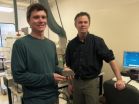(Press-News.org) University of Illinois research reports that several herbicides used on corn also have good selectivity to Miscanthus x giganteus (Giant Miscanthus), a potential bioenergy feedstock.
"No herbicides are currently labeled for use in Giant Miscanthus grown for biomass," said Eric Anderson, an instructor of bioenergy for the Center of Advanced BioEnergy Research at the University of Illinois. "Our research shows that several herbicides used on corn are also safe on this rhizomatous grass."
M. x giganteus is sterile and predominantly grown by vegetative propagation, or planting rhizomes instead of seed. This can be a very costly investment and requires a 1- to 2-year establishment period. Anderson's research showed that Giant Miscanthus does not compete well with weeds during establishment, especially early emerging weeds.
"There's a great cost in establishing Giant Miscanthus," Anderson said. "It's important to protect this investment, especially if it goes commercial. When weeds outcompete Giant Miscanthus, the result is stunted growth and lack of tillering. Basically, you are risking the crop's ability to overwinter."
The study, funded by the Ingersoll Fellowship, the Illinois Council on Food and Agricultural Research and the Energy Biosciences Institute, screened 16 post-herbicides and 6 pre-herbicides in a greenhouse setting. Several herbicides, particularly those with significant activity on grass species, caused plant injury ranging from 6 to 71 percent and/or reduced M. x giganteus dry mass by 33 to 78 percent.
Researchers then narrowed these herbicides down to the safest options and evaluated them in field trials replicated over two years. Field experiments confirmed the greenhouse experiments. Pre-emergence herbicides and herbicides with broadleaf-specific activity generally did not produce significant injury or reduce aboveground biomass while herbicides with considerable grass activity tended to cause injury ranging from 22 to 25 percent and reduce biomass by 69 to 78 percent.
"We discovered the anecdotes were true for the most part," he said. "Herbicides that are safe to use on corn demonstrate good selectivity to Giant Miscanthus."
Anderson said it's more difficult to kill a grass weed in a grass crop such as Giant Miscanthus. Identifying herbicides that don't hurt its yield or growth and maturity also posed challenges for researchers.
"I think the key is finding pre-emergence herbicides that you can get in early to take care of weed problems in Giant Miscanthus," he said.
Atrazine is one of the herbicides that proved safe on M. x giganteus.
"The good news is that atrazine is completely safe pre- or post-emergence," he said. "Atrazine is cheap and relatively effective. One of the major reasons we are continuing to screen more herbicides is to find additional effective options if atrazine utilization were limited in areas where Giant Miscanthus might be grown."
While there remains no approved label use for herbicides on M. x giganteus for biofuel production, Anderson hopes this research can serve as a foundation for either growers to begin an IR-4 specialty product process or for a major chemical company to add it to their label in the future.
Giant Miscanthus production is picking up in states such as Kentucky and Georgia, he said. He believes adding this feedstock to herbicide labels is not far off, but may be dependent on USDA's support of cellulosic ethanol.
INFORMATION:
This research, "Miscanthus x giganteus Response to Preemergence and Postemergence Herbicides," was published in Weed Technology. Researchers included Anderson, Thomas Voigt, Germán Bollero and Aaron Hager.
Miscanthus has a fighting chance against weeds
2011-01-11
ELSE PRESS RELEASES FROM THIS DATE:
Lake Erie hypoxic zone doesn't affect all fish the same, study finds
2011-01-11
WEST LAFAYETTE, Ind. - Large hypoxic zones low in oxygen long have been thought to have negative influences on aquatic life, but a Purdue University study shows that while these so-called dead zones have an adverse affect, not all species are impacted equally.
Tomas Höök, an assistant professor of forestry and natural resources, and former Purdue postdoctoral researcher Kristen Arend used output from a model to estimate how much dissolved oxygen was present in Lake Erie's hypoxic zone each day from 1987 to 2005. That information was compared with biological ...
Being poor can suppress children's genetic potentials
2011-01-11
AUSTIN, Texas — Growing up poor can suppress a child's genetic potential to excel cognitively even before the age of 2, according to research from psychologists at The University of Texas at Austin.
Half of the gains that wealthier children show on tests of mental ability between 10 months and 2 years of age can be attributed to their genes, the study finds. But children from poorer families, who already lag behind their peers by that age, show almost no improvements that are driven by their genetic makeup.
The study of 750 sets of twins by Assistant Professor Elliot ...
Possible missing link between young and old galaxies
2011-01-11
University of California, Berkeley, astronomers may have found the missing link between gas-filled, star-forming galaxies and older, gas-depleted galaxies typically characterized as "red and dead."
In a poster to be presented this week at the American Astronomical Society meeting in Seattle, UC Berkeley astronomers report that a long-known "early-type" galaxy, NGC 1266, is expelling molecular gas, mostly hydrogen, from its core.
Astronomers have long recognized the distinction between early-type red and dead galaxies, thought to be largely devoid of gas and dust and ...
Oxygen-free early oceans likely delayed rise of life on planet
2011-01-11
RIVERSIDE, Calif. – Geologists at the University of California, Riverside have found chemical evidence in 2.6-billion-year-old rocks that indicates that Earth's ancient oceans were oxygen-free and, surprisingly, contained abundant hydrogen sulfide in some areas.
"We are the first to show that ample hydrogen sulfide in the ocean was possible this early in Earth's history," said Timothy Lyons, a professor of biogeochemistry and the senior investigator in the study, which appears in the February issue of Geology. "This surprising finding adds to growing evidence showing ...
Does it hurt?
2011-01-11
It is well known that pain is a highly subjective experience. We each have a pain threshold, but this can vary depending on distractions and mood. A paper in the International Journal of Behavioural and Healthcare Research offers a cautionary note on measuring perceived pain in research.
There are many chronic illnesses and injuries that have no well-defined symptoms other than pain, but because of the subjectivity in a patient's reporting of their experience of the illness or injury, healthcare workers have difficulty in addressing the patient's needs. Moreover, when ...
New method takes snapshots of proteins as they fold
2011-01-11
People have only 20,000 to 30,000 genes (the number is hotly contested), but they use those genes to make more than 2 million proteins. It's the protein molecules that domost of the work in the human cell. After all, the word protein comes from the Greek prota, meaning "of primary importance."
Proteins are created as chains of amino acids, and these chains of usually fold spontaneously into what is called their "native form" in milliseconds or a few seconds.
A protein's function depends sensitively on its shape. For example, enzymes and the molecules they alter are ...
Universities miss chance to identify depressed students
2011-01-11
CHICAGO --- One out of every four or five students who visits a university health center for a routine cold or sore throat turns out to be depressed, but most centers miss the opportunity to identify these students because they don't screen for depression, according to new Northwestern Medicine research.
About 2 to 3 percent of these depressed students have had suicidal thoughts or are considering suicide, the study found.
"Depression screening is easy to do, we know it works, and it can save lives," said Michael Fleming, professor of family and community medicine ...
'Hot-bunking' bacterium recycles iron to boost ocean metabolism
2011-01-11
In the vast ocean where an essential nutrient—iron—is scarce, a marine bacterium that launches the ocean food web survives by using a remarkable biochemical trick: It recycles iron.
By day, it uses iron in enzymes for photosynthesis to make carbohydrates; then by night, it appears to reuse the same iron in different enzymes to produce organic nitrogen for proteins.
The bacterium, Crocosphaera watsonii, is one of the few marine microbes that can convert nitrogen gas into organic nitrogen, which (just as it does on land) acts as fertilizer to stimulate plant growth in ...
Men with macho faces attractive to fertile women, researchers find
2011-01-11
When their romantic partners are not quintessentially masculine, women in their fertile phase are more likely to fantasize about masculine-looking men than are women paired with George Clooney types.
But women with masculine-looking partners do not necessarily become more attracted to their partners, a recent study co-authored by a University of Colorado at Boulder researcher concludes.
Meanwhile, a man's intelligence has no effect on the extent to which fertile, female partners fantasize about others, the researchers found. They say the lack of an observed "fertility ...
GEN reports on biotech acquisition deals in 2010 that topped $1 billion
2011-01-11
New Rochelle, NY, January 10, 2011—The mega-mergers of 2009 did not continue into 2010. While the three biggest acquisitions in 2009 each had a price tag of more than $40 billion, only last year's top purchase got above that mark, according to an evaluation of reported deals conducted by Genetic Engineering & Biotechnology News (GEN) (http://www.genengnews.com/). The only other mega takeover for the year, sanofi-aventis' move to buy Genzyme, is still being worked out.
A look at 2010's buyouts that crossed the $1billion mark (http://www.genengnews.com/gen-news-highlights/acquisition-deals-in-2010-that-topped-1b/81244443/) ...




